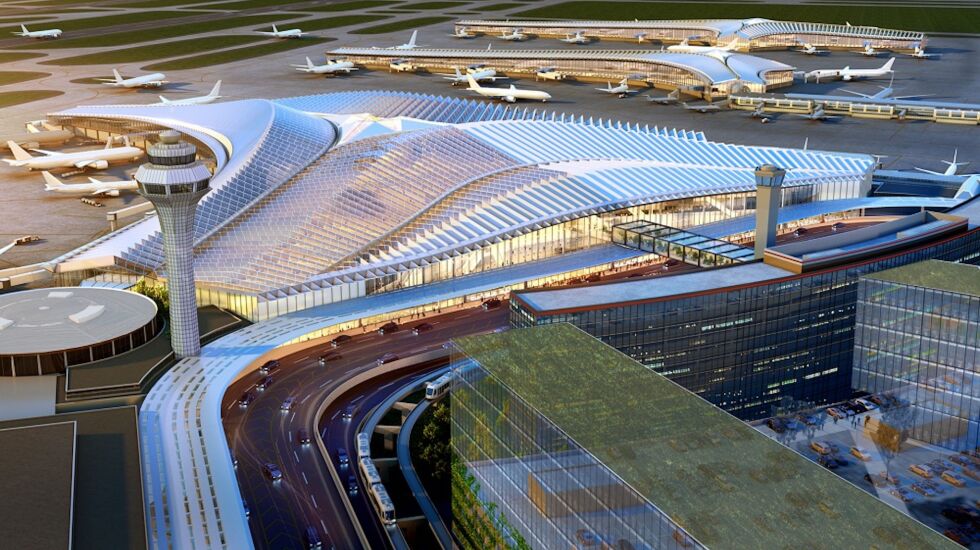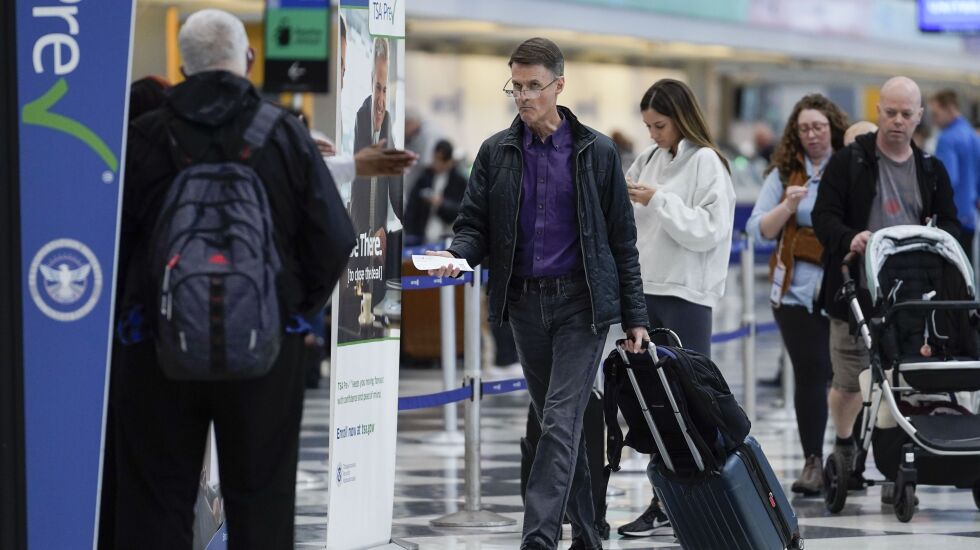
O’Hare Airport’s two largest carriers want to slow down, dramatically scale back or indefinitely ground the airport’s massive expansion project, including a global terminal and two satellite concourses now $1.5 billion over budget.
Ald. Matt O’Shea (19th), chairman of the City Council’s Aviation Committee, said high-stakes negotiations with hometown United and Dallas-based American Airlines have gone on for months. Those rival carriers — at loggerheads when the original agreement was signed in 2018 — are now joining forces.
“The two major carriers, United and American, want to see this project to be scaled back, to slow down,” O’Shea told the Sun-Times. Another meeting between the mayor’s office and both airlines was held Monday.
Their concern is “certainly, the cost,” O’Shea said. “Everything is significantly more expensive now than it was before the pandemic. They have stated that air travel, whether it be a combination of business, international, leisure travel — is not where it was in 2019. They’ve been vocal about that, particularly over the last several months.”
O’Shea said it is particularly “concerning” that United has revived a 2018 threat to move its corporate headquarters at Willis Tower out of Chicago.
Both airlines confirmed city officials have told them the next major phase of O’Hare work is $1.5 billion — 24% — over budget. Construction has yet to start on the next phase’s main elements, including the global terminal, designed by the firm of renowned Chicago architect Jeanne Gang.
One option could be to economize on the Gang design that some in the industry have derided as an expensive “Taj Mahal.”
O’Shea said he has no idea how Mayor Brandon Johnson will respond to the airlines’ demand — but he knows what the mayor’s answer should be.
“O’Hare and Midway need to be modernized. Need to be improved,” O’Shea said. “Parts of both those airports are old and tired. … During the pandemic, were it not for cargo, I don’t know what would have happened at O’Hare Airport. Top airports throughout the country continue to come after us, looking to take passengers. Looking to become stronger hubs. And we need to stay competitive.”

Global terminal key part of expansion
United and American were tight-lipped about sensitive negotiations over the new global terminal, which would replace Terminal 2. It’s the core of O’Hare’s Terminal Area Program, or TAP. “Work on the most expensive TAP elements has yet to begin — we have concerns that costs will escalate further after the work begins,” United and American wrote in a joint statement.
The carriers added, however, that they remain committed to modernizing O’Hare. The work is funded by airline ticket taxes, landing fees and other revenue sources at the airport.
In a separate statement, United said it remains “committed to building a bigger, stronger, more efficient and modernized” O’Hare, just as it has done “at many of our other hub markets.” But costs on a project bankrolled in part by airline ticket taxes must be controlled, the airline stated.
“We continue to work with the city of Chicago and our fellow airlines to advance the terminal redevelopment program in a manner that not only ensures O’Hare’s future financial stability and competitiveness, but also limits costs for the millions of passengers who fly through Chicago’s airport each year,” the United statement said.
American Airlines said it also will work with the Johnson administration “to deliver a capital plan that will enhance the customer experience in a prudent and cost-effective manner to keep O’Hare well-positioned for the future and cost competitive for the airline and our customers.”
Aviation Commissioner Jamie Rhee, a Rahm Emanuel administration holdover who took over after hard-fought negotiations with the airlines in 2018, refused to comment on the delicate talks with United and American.
Instead she issued a statement that did not disclose what exactly the two major carriers were demanding, their reasoning for seeking a change or what, if anything, United and American have threatened to do if they do not get what they want.
The statement simply said the Chicago Department of Aviation “remains committed to the continued growth and development” of O’Hare “through … a once-in-a-generation investment in the airport’s terminal facilities to meet the needs of all airline partners, airport employees and the traveling public in the 21st century.”
The statement noted “enabling work for the next phase of this vital infrastructure project” began in March and the department “remains engaged in consultation with airline, agency and business partners on the complex phasing and implementation associated with a development of this magnitude.”
Johnson’s chief operating officer, John Roberson, who served as aviation commissioner under Mayor Richard M. Daley, told the Sun-Times he “can’t say anything just yet” about the sensitive talks.
“We’re not doing anything. We’re having discussions with the airlines. Aviation has met with the airlines on a number of occasions. Those discussions are still going. … We value our partnership with the airlines as we always have,” Roberson said.
Asked whether Johnson was more inclined to modify the 2018 agreement, or will instead insist United and American honor the contract, Roberson replied, “I can’t speak to anything related to what the mayor is thinking right now.”
A deal’s a deal, Emanuel says
Emanuel urged Johnson to stand firm and demand that United and American honor the contract they signed in 2018.
That includes plans for a greatly enlarged facility that would allow United and American to combine domestic and international flights in the same place. It would make O’Hare the nation’s first “global alliance hub,” with domestic airlines and their international carrier partners all in the same terminal.
Delta Airlines got more breathing room by shifting its operations from Terminal 2 to the newly expanded international terminal, officially Terminal 5, where its Sky Team alliance partners are located.
“Across the globe and everywhere, people are modernizing their aviation systems and Chicago should be no different. They signed onto it. It’s a contract,” said Emanuel, who is now serving as U.S. ambassador to Japan.
“They got the additional gates already. And Chicago should get the modernization,” Emanuel continued. “That’s part of the agreement that they signed. It was good then that they signed on. And it’s good now — especially considering that airports are busier than ever before. It’s not like air travel is declining.
“There are certain things they wanted. Those have already been delivered. … We modernized the runways. And we’re now going to modernize the terminals so it stays the premier, No. 1 airport and aviation hub not only in the United States, but in the globe.”
In 2020 when airlines also raised concerns about O’Hare improvement costs, they were worried their business was collapsing due to the pandemic. Now overall passenger loads have returned to pre-pandemic levels, although industry experts say business travel has been slower to return than the leisure trade.
United said its third-quarter profit rose 21%, to $1.14 billion, largely on summer vacations. But it warned near-term profits will be affected by rising jet fuel prices and a suspension of flights to Tel Aviv because of the Israel-Hamas war.
American posted worse results in the third quarter, a $545 million loss on revenue that was flat from the same period a year ago. It blamed higher costs, including a new labor agreement that increases pilots’ pay.
Aviation business looking up
But the business outlook for aviation remains much better than it was during the pandemic, and may make it harder for the carriers to drive a hard bargain with the city.
The decision by United and American to join forces in demanding the expansion slowdown is a reversal from what happened in 2018, when American and United were bitter adversaries.
At one point, American accused Emanuel of favoring United by awarding the hometown airline five additional gates. American threatened to file a lawsuit, shrink its dual hub at O’Hare — or both — in the high-stakes dispute over new gates.
American even sought communications between Emanuel and his top aides and United in an attempt to determine whether a United threat to pull its corporate headquarters out of Chicago had prompted Emanuel to award those five gates to United, the airport’s largest carrier.
“We want to know if we’re getting a fair shake here,” Mike Minerva, American’s then-vice president of government and airport affairs, said at the time.
Asked then about a threat by United to move its corporate headquarters out of Chicago, Minerva said, “We have heard that has been discussed.”
In 2012, United moved its corporate headquarters from Elk Grove Village to Willis Tower. United at the time denied having threatened to “leave Chicago or move the corporate headquarters, nor did we ever discuss it.”

In the early months of the pandemic, the Sun-Times reported the O’Hare expansion would be delayed and potentially scaled back because airlines — fighting for survival after air travel virtually ground to a halt — could not afford their share of what was then an $8.7 billion project. The total cost is now pegged at $12.1 billion.
At the time, security screenings showed passenger traffic was down 95% from the year before the pandemic.
In January, then-Mayor Lori Lightfoot presided at the opening of the new 10-gate extension of Terminal 5. The futuristic, L-shaped extension has 10 gates, all able to handle wide-body jets. Nine have “multiple aircraft ramp systems” capable of accommodating narrow-body jets as well, providing the flexibility to park a pair of wide-body jets in space that can also accommodate three narrow-body jets.
Four years in the making, the $1.3 billion project increased by 25% the capacity of an international terminal once located in the ground floor of an O’Hare parking garage. That increased capacity will mean fewer delays. Space for passenger amenities was increased by 75%, with a smorgasbord of new concessions showcasing Chicago restaurants and vendors.
Other plans for the international terminal include an adjacent hotel and roadway improvements. Neither have been designed — or, more crucially, approved by the airlines that pay the bills.






!["[T]he First and Fifth Amendments Require ICE to Provide Information About the Whereabouts of a Detained Person"](https://images.inkl.com/s3/publisher/cover/212/reason-cover.png?w=600)

